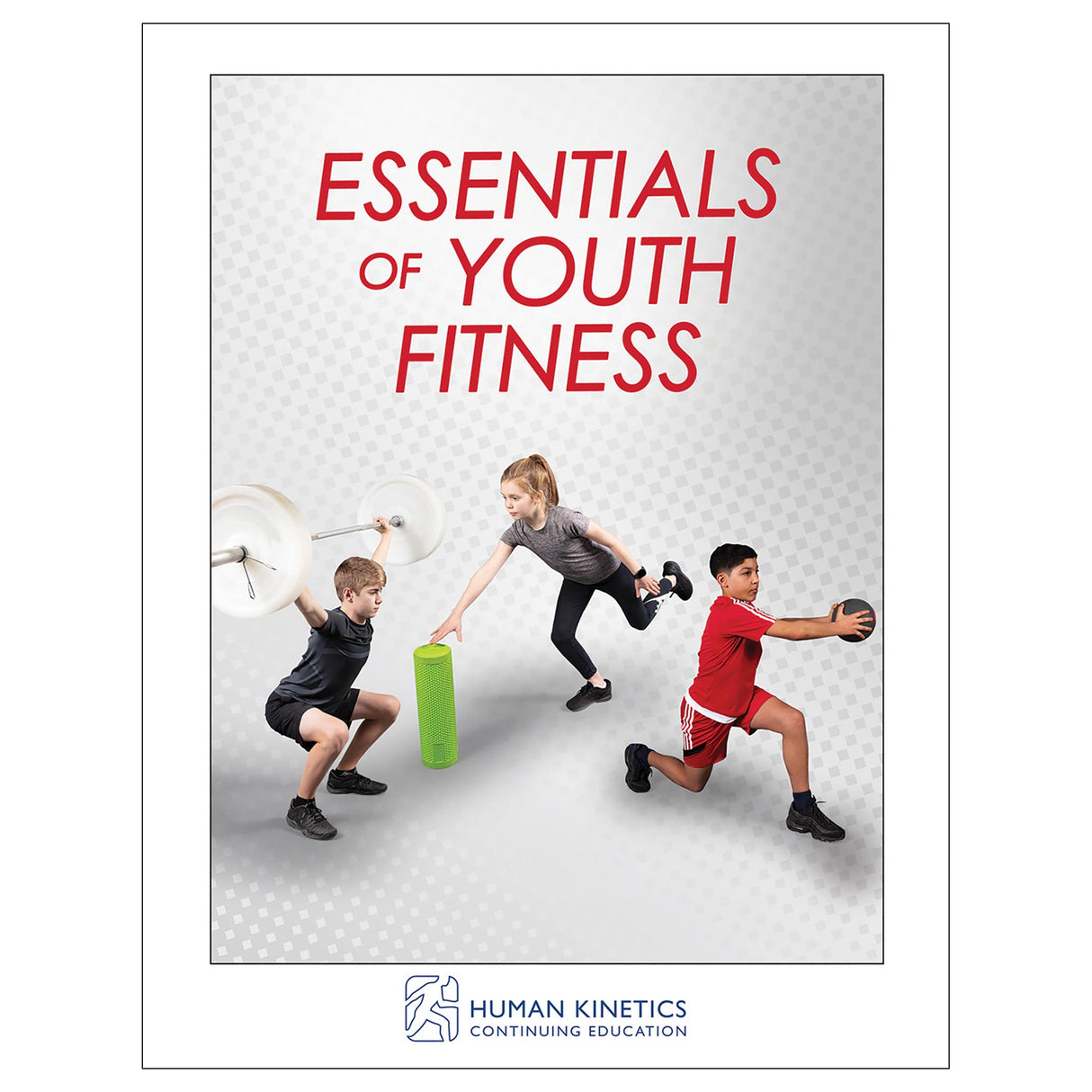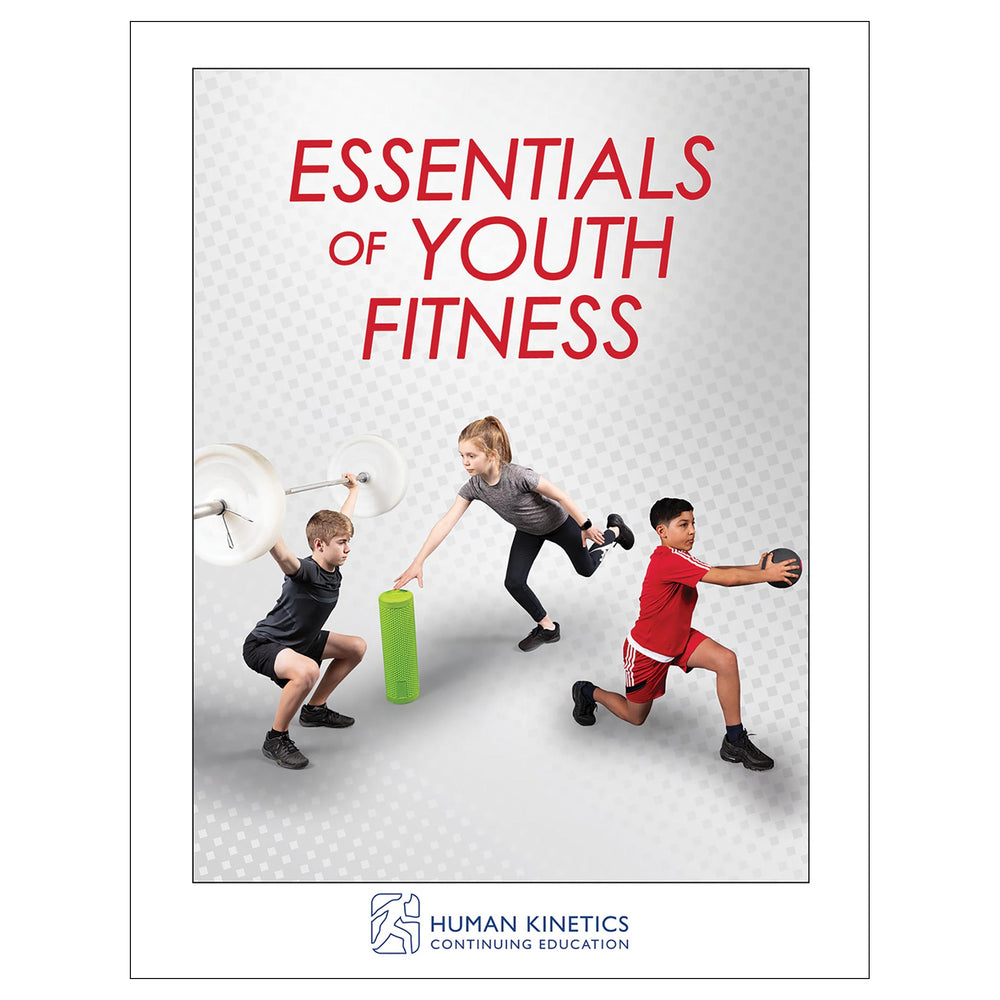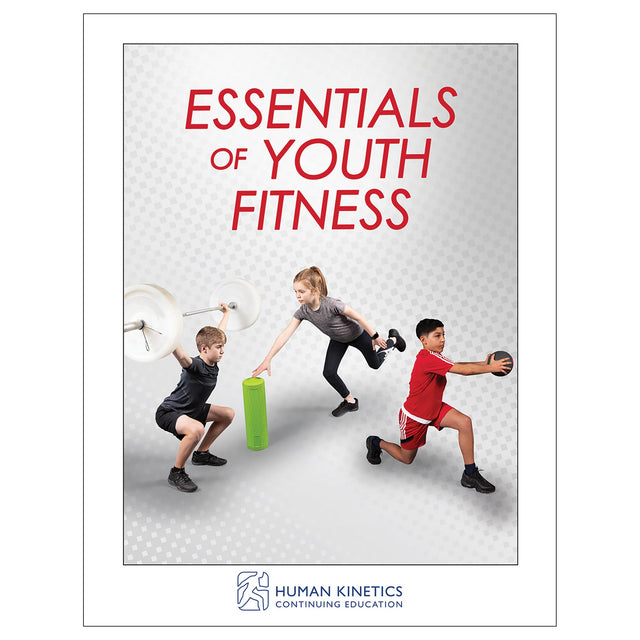This package includes the following:
-
Essentials of Youth Fitness book
- Online continuing education exam
Essentials of Youth Fitness is an evidence-informed, practical guide for fitness and strength and conditioning professionals working with younger clientele. Backed by the American College of Sports Medicine (ACSM) and coauthored by three leading authorities in pediatric exercise science, this cutting-edge book is built around the modern understanding that youth are not simply smaller versions of adults but are instead a special population with their own specific needs. You’ll understand the scientific theories behind youth training as well as how to apply them to help design effective programs that maximize creativity, engagement, and fun.
The text is broken into three parts to systematically bridge the gap between science and practice. Part I lays the groundwork for understanding fundamental concepts of pediatric exercise science, including physiology, growth and maturation, long-term athletic development, and pedagogical strategies.
Part II is devoted to the assessment of youth development of fitness components, including motor skill, strength and power, speed and agility, and aerobic and anerobic fitness. This practical section demonstrates the impact of factors specific to youth on fitness, and it will teach you how to design integrative training programs to meet the needs of youth of varying abilities and different stages of development. Sample training sessions with accompanying exercise photos within each chapter offer clear visual guidelines for implementing exercises correctly.
Part III delves into modern-day topics specific to the youth population, including participation in organized sports and injury concerns; overweight and obese youth; those diagnosed with clinical conditions such as diabetes, asthma, and physical and mental disabilities; and the role of nutrition in healthy lifestyle habits.
Learning aids throughout the book enhance comprehension and enable you to quickly locate important information. Chapter objectives and key terms reinforce learning, while Teaching Tip boxes contextualize important themes, and Do You Know? boxes illustrate practical application of the content.
After reading the book, certified professionals can take the companion CE exam to earn continuing education credits.
Learning Objectives
- Explain the long-term effects of physical inactivity on disease risk.
- Introduce physical activity recommendations from infancy through adolescence.
- Describe how biological and physiological systems develop during childhood and adolescence.
- Explain the differences between skeletal, sexual, and somatic maturation.
- Critically analyze the benefits and limitations of existing talent and athletic developmental models for youth.
- Evaluate test batteries for assessing physical fitness.
- Provide an overview of dynamic warm-up procedures for children and adolescents.
- Define the classifications of motor skills.
- Design strength and power training programs for children and adolescents.
- Define classifications of speed and agility.
- Discuss the determinants of aerobic and anaerobic fitness.
- Distinguish the hierarchical order of multilevel programming.
- Describe the risks associated with excessive training in young athletes.
- Explain the benefits of aerobic, resistance, and combined exercise training for youth who are overweight or obese.
- Describe appropriate exercise training strategies for youth with clinical conditions.
- Discuss the roles of nutrition and energy balance in supporting growth, maturation, and a healthy lifestyle.
Audience
Certified fitness professionals, personal trainers, and strength and conditioning coaches working with young athletes and clients.
Part I. Fundamental Concepts
Chapter 1. Physical Activity and Children’s Health
Chapter 2. Principles of Pediatric Exercise Science
Chapter 3. Growth, Maturation, and Physical Fitness
Chapter 4. Long-Term Athletic Development
Chapter 5. Pedagogy for Youth Fitness Specialists
Part II. Youth Fitness Development
Chapter 6. Assessing Youth Fitness
Chapter 7. Dynamic Warm-Up and Flexibility
Chapter 8. Motor Skill Training
Chapter 9. Strength and Power Training
Chapter 10. Speed and Agility Training
Chapter 11. Aerobic and Anaerobic Training
Chapter 12. Integrative Program Design
Part III. Contemporary Issues
Chapter 13. Young Athletes and Sport Participation
Chapter 14. Exercise for Overweight and Obese Youth
Chapter 15. Exercise for Youth With Selected Clinical Conditions
Chapter 16. Nutrition for Youth
Avery Faigenbaum, EdD, is a full professor in the department of health and exercise science at The College of New Jersey. His research interests focus on pediatric exercise science, resistance exercise, and preventive medicine, and he is devoted to bridging the gap between the laboratory and the playing field. As an active researcher and practitioner, Faigenbaum has coauthored over 240 peer-reviewed publications, 45 book chapters, and 10 books, including Youth Strength Training, Strength and Power for Young Athletes, and Progressive Plyometrics for Kids. He has been an invited speaker at more than 300 conferences throughout the world.
Faigenbaum is a fellow of the American College of Sports Medicine (ACSM) and of the National Strength and Conditioning Association (NSCA), and he serves as associate editor of Pediatric Exercise Science and the Journal of Strength and Conditioning Research. He was elected vice president of the NSCA in 2005 and served on the Massachusetts Governor’s Committee on Physical Fitness and Sports from 1998 to 2004. Faigenbaum was awarded the Boyd Epley Award for Lifetime Achievement from the NSCA in 2017.
Rhodri Lloyd, PhD, is a reader in pediatric strength and conditioning and the chair of the Youth Physical Development Centre at Cardiff Metropolitan University. He also holds a research associate position with Auckland University of Technology. Lloyd’s research interests surround the impact of growth and maturation on long-term athletic development and the neuromuscular mechanisms underpinning training adaptations in youth. To date he has published in excess of 90 peer-reviewed publications and more than 20 book chapters on the topics of youth fitness and pediatric strength and conditioning. He is a senior associate editor for the Journal of Strength and Conditioning Research and an associate editor for the Strength and Conditioning Journal. In 2016, he received the Strength and Conditioning Coach of the Year award for research and education from the UK Strength and Conditioning Association, and in 2017 he was awarded the Terry J. Housh Outstanding Young Investigator Award from the National Strength and Conditioning Association (NSCA). In 2019, he was again recognized by the NSCA, receiving both the Journal of Strength and Conditioning Research Editorial Excellence Award and Educator of the Year Award.
Jon Oliver, PhD, is a professor of applied pediatric exercise science at Cardiff Metropolitan University, where he cofounded the Youth Physical Development Centre. He is also an adjunct professor at the Sport Performance Research Institute New Zealand (SPRINZ). His research focuses on youth physical development across performance, injury, and health perspectives, with an emphasis on the role of strength and conditioning to promote athletic development at all levels. He has published over 100 international peer-reviewed articles, contributed to international position and consensus statements, and authored numerous book chapters. Oliver’s research has been influential in informing both academics and practitioners on factors related to the development of physical fitness in youth. This has included developing coach education materials for professional sports organizations and national governing bodies. His research is supported by a network of research students and is built on collaborations with professional sports organizations and pediatric exercise scientists, both in the United Kingdom and in other countries.
The American College of Sports Medicine (ACSM), founded in 1954, is the largest sports medicine and exercise science organization in the world. With more than 50,000 members and certified professionals worldwide, ACSM is dedicated to improving health through science, education, and medicine. ACSM members work in a wide range of medical specialties, allied health professions, and scientific disciplines. Members are committed to the diagnosis, treatment, and prevention of sport-related injuries and the advancement of the science of exercise. The ACSM promotes and integrates scientific research, education, and practical applications of sports medicine and exercise science to maintain and enhance physical performance, fitness, health, and quality of life.





